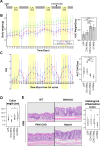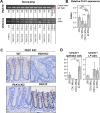An unexpected tumor-resistant phenotype from floxing PAK1 in a mouse model of colitis associated cancer
- PMID: 40783411
- PMCID: PMC12335604
- DOI: 10.1038/s41598-025-12082-8
An unexpected tumor-resistant phenotype from floxing PAK1 in a mouse model of colitis associated cancer
Abstract
Inflammatory bowel disease (IBD) and colitis-associated cancer are associated with activation of PAK1 (p-21 activated kinase 1). We previously found that total knockout of PAK1 (PAK1KO) reduced tumorigenesis upon AOM/DSS but enhanced tumorigenesis in another model of IBD with total knockout of IL10 (IL10KO). To better understand the specific role of epithelial PAK1, we crossed Pak1 floxed (PAK1fl) with VillinCre mice for a conditional knockout of PAK1 in intestinal epithelia (PAK1CKO). PAK1fl were included as additional controls. Unexpectedly, inflammation and tumorigenesis were greatly reduced in PAK1fl compared to WT or PAK1KO after AOM/DSS treatment. PAK1CKO had higher tumor incidence and counts compared to PAK1fl, but was still lower in comparison to PAK1KO or WT. When crossed with IL10KO mice, PAK1CKO exacerbated the expected hyperproliferative phenotype, resulting in early mouse morbidity. Despite normal Pak1 mRNA expression in PAK1fl colonic lysates, PAK1 protein expression on immunohistochemistry was higher that WT. Both PAK1fl and PAK1CKO mice were more resistant to shifts in microbiome, and remained clustered together compared to WT or PAK1KO. Altogether, our results suggest that floxing itself may have altered Pak1 expression, which conferred protection from AOM/DSS carcinogenesis.
Keywords: AOM/DSS; Colitis-associated cancer; Cre-LoxP; IL10; Inflammatory bowel disease; P-21 activated kinase 1; PAK1.
© 2025. The Author(s).
Conflict of interest statement
Declarations. Competing interests: The authors declare no competing interests.
Figures




Similar articles
-
Inhibition of P21-activated kinases 1 and 4 synergistically suppresses the growth of pancreatic cancer by stimulating anti-tumour immunity.Cell Commun Signal. 2024 May 27;22(1):287. doi: 10.1186/s12964-024-01670-2. Cell Commun Signal. 2024. PMID: 38797819 Free PMC article.
-
Engineered Probiotic Saccharomyces boulardii Reduces Colitis-Associated Colorectal Cancer Burden in Mice.Dig Dis Sci. 2025 Jul;70(7):2348-2367. doi: 10.1007/s10620-025-09008-9. Epub 2025 Mar 29. Dig Dis Sci. 2025. PMID: 40156662 Free PMC article.
-
A Novel PAK1-Notch1 Axis Regulates Crypt Homeostasis in Intestinal Inflammation.Cell Mol Gastroenterol Hepatol. 2021;11(3):892-907.e1. doi: 10.1016/j.jcmgh.2020.11.001. Epub 2020 Nov 12. Cell Mol Gastroenterol Hepatol. 2021. PMID: 33189893 Free PMC article.
-
Vitamin D for the treatment of inflammatory bowel disease.Cochrane Database Syst Rev. 2023 Oct 2;10(10):CD011806. doi: 10.1002/14651858.CD011806.pub2. Cochrane Database Syst Rev. 2023. PMID: 37781953 Free PMC article.
-
Systemic treatments for metastatic cutaneous melanoma.Cochrane Database Syst Rev. 2018 Feb 6;2(2):CD011123. doi: 10.1002/14651858.CD011123.pub2. Cochrane Database Syst Rev. 2018. PMID: 29405038 Free PMC article.
References
-
- Dammann, K., Khare, V. & Gasche, C. Tracing PAKs from GI inflammation to cancer. Gut63, 1173–1184. 10.1136/gutjnl-2014-306768 (2014). - PubMed
MeSH terms
Substances
Grants and funding
LinkOut - more resources
Full Text Sources
Molecular Biology Databases
Research Materials

